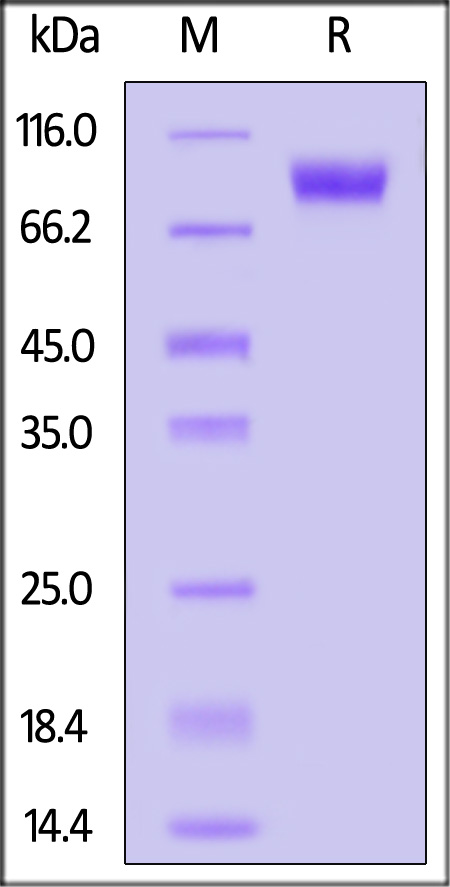分子别名(Synonym)
NKG2A & CD94
表达区间及表达系统(Source)
Mouse NKG2A&CD94, Fc Tag (NC4-M5254) is expressed from human 293 cells (HEK293). It contains AA Thr 95 - Ile 244 (NKG2A) & Ile 32 - Ile 179 (CD94) (Accession # Q9Z202-1(NKG2A) & O54707-1(CD94)).
Predicted N-terminus: Thr 95
蛋白结构(Molecular Characterization)
This protein carries a human IgG1 Fc tag at the C-terminus.
The protein has a calculated MW of 61.3 kDa. The protein migrates as 70-80 kDa under reducing (R) condition (SDS-PAGE) due to glycosylation.
内毒素(Endotoxin)
Less than 1.0 EU per μg by the LAL method.
纯度(Purity)
>95% as determined by SDS-PAGE.
制剂(Formulation)
Lyophilized from 0.22 μm filtered solution in PBS, pH7.4. Normally trehalose is added as protectant before lyophilization.
Contact us for customized product form or formulation.
重构方法(Reconstitution)
Please see Certificate of Analysis for specific instructions.
For best performance, we strongly recommend you to follow the reconstitution protocol provided in the CoA.
存储(Storage)
For long term storage, the product should be stored at lyophilized state at -20°C or lower.
Please avoid repeated freeze-thaw cycles.
This product is stable after storage at:
- -20°C to -70°C for 12 months in lyophilized state;
- -70°C for 3 months under sterile conditions after reconstitution.
电泳(SDS-PAGE)

Mouse NKG2A&CD94, Fc Tag on SDS-PAGE under reducing (R) condition. The gel was stained with Coomassie Blue. The purity of the protein is greater than 95%.
背景(Background)
CD94 plays a role as a receptor for the recognition of MHC class I HLA-E molecules by NK cells and some cytotoxic T-cells. KLRD1 (CD94) is an antigen preferentially expressed on NK cells and is classified as a type II membrane protein because it has an external C terminus. NKG2A/CD159a is a transmembrane protein belonging to the CD94/NKG2 family of C-type lectin-like receptors that inhibits innate immune system activation. CD94 pairs with the NKG2 molecule as a heterodimer. The CD94/NKG2 complex, on the surface of natural killer cells interacts with Human Leukocyte Antigen (HLA)-E on target cells.























































 膜杰作
膜杰作 Star Staining
Star Staining












